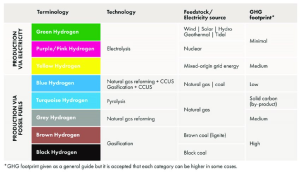How to become a green hydrogen superpower
Why in News?
The 2023 Union Budget has allocated ₹19,700 crore for the National Green Hydrogen Mission. This could help India establish itself as a green H2 superpower.

What is green hydrogen?
- It is a type of hydrogen produced by splitting water through electrolysis, using an electrolyser powered entirely by renewable power sources.
- Advantages –It could replace fossil fuels and decarbonize a range of sectors such as petroleum refining, fertiliser production, steel production, chemicals, transport, etc.
- Disadvantages – It is not commercially viable at present and is expensive to be manufactured.

What is the National Green Hydrogen Mission?
- The National Green Hydrogen Mission was first announced by the Prime Minister in his Independence Day speech in 2021.
- Objectives – The mission is aimed at making India a global hub for the production of green hydrogen.
- The mission also aims to:
- Creation of export opportunities for green hydrogen.
- Decarbonisation of the energy sector.
- Development of indigenous manufacturing capacities.
Importance of Green H2 for India:
- India has committed to 50% electricity capacity from non-fossil sources by 2030.
- An energy transition in the industry (most GHG emissions come from steel, cement, fertilizers, and petrochemicals) is needed at the same time.
- Green H2 can serve as an energy source(heavy industry, mobility, and power storage) and an energy carrier (as green ammonia/blended with natural gas). It holds the promise of fuelling industrial growth while simultaneously reducing industrial emissions.
- With abundant sunshine and wind energy resources, India is geographically blessed to become one of the lowest-cost producers of green H2.
Priorities to convert the vision into reality:
Government and industry must act in sync for –
- Becoming a big player domestically– a necessity to be a major player in the international market.
- The mission introduces a Strategic Interventions for Green Hydrogen Transition (SIGHT) fund (₹13,000 crores) to support heavy industries to increase demand, offering economies of scale, etc.
- Blending mandates for refineries can be another demand trigger.
- As the second-largest steel producer in the world, India can aspire to become the largest green steel producer.
- Costs of green steel, made from green H2, could be reduced with economies of scale and changes in production technologies.
- India can be an attractive destination for domestic and foreign investment.
- A mission secretariat can ensure project clearance is streamlined and reduce financial risks.
- Becoming more competitive (with targeted public funding) in manufacturing the most critical and high-value components of electrolysers in India.
- The SIGHT fund offers ₹4,500 crores to support electrolyser manufacturing under the performance-linked incentive scheme.
- The mission allocates ₹400 crores for R&D, which can be leveraged to crowd in private capital into technology co-development
- Establishing bilateral partnerships to develop resilient supply chains.
- Indian companies should consider joint projects in countries with good renewable energy resources and cheap finance to become export competitive.
- India must coordinate with major economies to develop rules for a global green H2 economy.
- India’s G20 presidencyis an opportunity to craft rules, addressing operational threats, industrial competitiveness and strategic threats.
- India should promote a global network of green hydrogen via which companies could collaborate.
Way Forward
- G20 –India’s G20 presidency is an opportunity to craft rules for a global green hydrogen economy. These rules must address operational threats, industrial competitiveness and strategic threats.
- Global network – India should promote a global network on green hydrogen via which companies could collaborate.
- India’s geography – With abundant sunshine and significant wind energy resources, India is geographically blessed to become one of the lowest-cost producers of green hydrogen.
- India is well-positioned to show leadership, in our collective interest and that of the planet.
Conclusion
Green hydrogen will be a critical industrial fuel of the 21st century. India is well-positioned to show leadership, which is in India’s and the planet’s collective interest.
